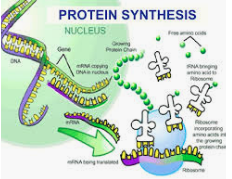PROTEIN SYNTHESIS Multiple Choice Questions MCQs
1. On the ribosome, mRNA binds
A. between the subunits
B. to the large subunit
C. to the small subunit
D. none of these
Answer: C
2. Type I proteins (plasma membrane) have a
A. cleavage N- terminal signal sequence and a hydrophobic stop transfer sequence
B. cleavaged N- terminal signal sequence that doubles as the membrane anchoring sequence
C. multiple signal sequence and a hydrophobic stop transfer sequence
D. multiple signal sequence that doubles as the membrane anchoring sequence
Answer: A
3. Which of the following is not a necessary component of translation?
A. Anticodon
B. mRNA
C. Ligase
D. Amino acid
Answer: C
4. A polysome could be best described as
A. an active site of DNA synthesis.
B. an active site of protein synthesis.
C. an active site of lipid synthesis.
D. all of the above.
Answer: B
5. Eukaryotic mRNA binding to the ribosomes is facilitated by __________ .
A. the Shine Dalgarno sequence
B. the 7-methyl guanosine cap
C. tRNA
D. poly A tail
Answer: B
6. Amino acids are joined together into a protein chain by which of the following?
A. Transfer RNA
B. DNA polymerase
C. Hydrogen bonds
D. Messenger RNA
Answer: A
7. Phosphorus is taken up by the cell during the process of
A. carbohydrate synthesis.
B. protein synthesis,
C. lipid synthesis.
D. ATP synthesis.
Answer: D
8. Protein synthesis rates in prokaryotes are limited by the rate of mRNA synthesis. If RNA synthesis occurs at the rate of 50 nucleotides/sec, then rate of protein synthesis occurs at
A. 10 amino acids/sec
B. 17 amino acids/sec
C. 25 amino acids/sec
D. 50 amino acids/sec
Answer: B
9. The site of protein synthesis is
A. Ribosome
B. Nucleus
C. Endoplasmic reticulum
D. Chromosome
Answer: A
10. The structure in a bacterium that indicates an active site for protein synthesis is
A. a chromosome.
B. a cell membrane,
C. a flagellum.
D. a polysome.
Answer: D

PROTEIN SYNTHESIS Objective type Questions with Answers
11. The lac operon contains the z, y and a structural genes
A. encoding p-galactosidase, galactose permeases and thio-galactosidase transacetylase respectively
B. encoding p-galactosidase and galactose permeases
C. encoding P-galactosidase only
D. None of the above
Answer: A
12. Proteins contain __________ different amino acids, whereas DNA and RNA are composed of __________ different nucleotides
A. 20,64 B. 3,20
C. 4,20 D. 20,4
Answer: D
13. Which of the following is not necessary for protein synthesis to occur, once transcription is completed?
A. tRNA
B. Ribosomes
C. mRNA
D. DNA
Answer: D
14. Ribosomes select the correct tRNAs
A. then bind to the appropriate mRNA
B. solely on the basis of their anticodons
C. depending on their abundance in the cytosol
D. with the least abundant anticodons
Answer: B
15. Signal peptide protein removal that is translocated across a membrane is accomplished by
A. fMet aminopeptidase
B. trypsin
C. signal peptidase
D. chymotrypsin
Answer: C
16. The direction of amino acid transfer to the growing polypeptide chain is
A. from the A (aminoacyl tRNA site) site to the P (peptidyl tRNA site) site on the ribosome
B. from the P site to the A site on the ribosome
C. from the A site to the E (exit tRNA site) site on the ribosome
D. from the P site to the E site on the ribosome
Answer: B
17. The pathway of a tRNA during polypeptide elongation on the ribosome is
A. A site ? P site ? E site
B. P site ? entry site ? exit site
C. A site ? P site ? entry site
D. P site ? A site ? E site
Answer: A
18. Which of the following has unusual bases?
A. mRNA
B. tRNA
C. rRNA
D. hnRNA
Answer: B
19. The site on a bacterial chromosome that marks the termination point for chromosome replication is called
A. ter
B. a stop codon.
C. a stem-loop
D. pau
Answer: A
20. Degenerated codon differs mostly in
A. the identities of their second base
B. the identities of their third base
C. the wobble position
D. both (b) and (c)
Answer: D
21. Translation in prokaryotes begins by the formation of a 30S initiation complex between the
A. 30S ribosomal subunit, mRNA, initiation factors and N-fMet tRNA
B. 30S ribosomal subunit, tRNA and initiation factors
C. 30S ribosomal subunit and mRNA only
D. 30S ribosomal subunit, mRNA and initiation factors
Answer: A
22. The anticodon of tRNA
A. binds to rRNA
B. binds to an amino acid
C. binds to the Shine Dalgarno sequence
D. binds to an mRNA codon
Answer: D
23. The peptidyl transferase reaction occurs
A. on the large subunit
B. on the small subunit
C. between the subunit
D. none of these
Answer: A
24. Processive synthesis is a characteristic feature of
A. all DNA polymerases.
B. DNA Pol III at a replication fork.
C. removal of RNA primers on Okasaki fragments.
D. DNA mismatch repair
Answer: B
25. Which site of the tRNA molecule binds to the mRNA molecule?
A. Anticodon
B. Codon
C. Amino acid
D. 5 prime end
Answer: A